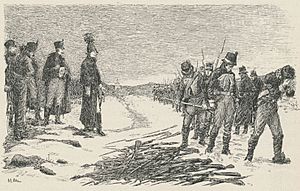Capitulation of Kalix facts for kids
Quick facts for kids Capitulation of Kalix |
|||||||
|---|---|---|---|---|---|---|---|
| Part of the Finnish War (Napoleonic Wars) | |||||||
 Disarming of the Finns, Magnus Adlercreutz |
|||||||
|
|||||||
| Belligerents | |||||||
| Commanders and leaders | |||||||
| Strength | |||||||
| 3,800 | 6,000–9,000 | ||||||
| Casualties and losses | |||||||
| 3,800 surrendered (excluding an additional battalion that was not present at Kalix but surrendered according to the convention) | Insignificant | ||||||
The Capitulation of Kalix was an important event during the Finnish War. It happened on March 25, 1809. About 3,800 to 4,500 Swedish and Finnish soldiers, led by Hans Henrik Gripenberg, surrendered. They gave up to a much larger Russian army. This Russian force was led by Pavel Andreyevich Shuvalov. This surrender was part of a big Russian attack on Sweden. Many Swedish leaders thought this surrender was a very bad decision. Because of this, Gripenberg's actions were later investigated by military officials.
Why Did the Capitulation of Kalix Happen?
After Russia took control of Finland, the Russian emperor Alexander I of Russia wanted to end the war quickly. He ordered a big attack on Sweden from three different directions. This attack started while Sweden was going through a major change. Their king, Gustav IV Adolf, was removed from power.
On March 10, 1809, a large Russian army moved towards Åland. They wanted to capture these islands. This would help them continue their attack towards Stockholm, the capital of Sweden. Another Russian force crossed the Kvarken strait. They made the Swedish commander at Umeå retreat. However, this Russian force was soon ordered to go back. This was because of talks that started after the Åland attack.
At the same time, Pavel Andreyevich Shuvalov led a Russian army of 9,000 soldiers. They moved towards Sweden's northern border, near the Torne River. They pushed a Swedish force of 3,000 soldiers, led by Hans Henrik Gripenberg, back. Gripenberg then set up a defense line behind the Kalix River. He planned to slow down the Russian advance.
What Happened at Kalix?
The first Russian soldiers met the Swedish soldiers at Sangis. But the fighting stopped quickly, and both sides started to talk. General Gripenberg felt that his situation was hopeless. The Russians were moving around his army's side. He also received a letter from another general. This letter wrongly said the Russian army was much bigger, with 10,000 to 11,000 soldiers.
Gripenberg believed his army would be cut off from southern Sweden. The Russians also promised that the Swedish soldiers would be sent home instead of being kept as prisoners. This was if they agreed to leave the war. So, on March 25, Gripenberg surrendered. This agreement was called the Convention of Säivis.
Most of Gripenberg's soldiers were experienced Finns. As they marched through Tornio, they gave up their weapons at Kemi Church. Then, they went home to Finland. In total, about 7,075 people were part of this surrender. This number included sick people and those not directly fighting. It also included soldiers who were not even at Kalix. For example, one Swedish battalion refused to surrender and was captured later.
At the time, many people in Sweden saw this surrender as a very bad decision. However, considering what Gripenberg knew and the difficult situation he was in, he was not entirely to blame. Even though the Russians had attacked from three sides, they did not achieve a quick peace. The war continued until September 17, 1809. This war eventually led to Finland becoming part of Russia, ending the union of Sweden and Finland.
What Military Units Were Involved?
Many different military groups were part of the agreement at Kalix. These included:
- Nyland Dragoon Regiment: Three groups of cavalry soldiers.
- Åbo Infantry Regiment: Three groups of foot soldiers.
- Nyland Infantry Regiment: One group of foot soldiers.
- Björneborg Infantry Regiment: Three groups of foot soldiers.
- Österbotten Infantry Regiment: One group of foot soldiers and one company.
- Tavastehus Infantry Regiment: Two groups of foot soldiers and three companies.
- Nyland Jäger Battalion: Three companies of light infantry.
- Västerbotten Infantry Regiment: One group of foot soldiers (the other refused to surrender).
- Finnish and Swedish land and sea artillery: 10 cannons.
- Savolax Artillery Regiment
- Archipelago fleet (a naval force)

